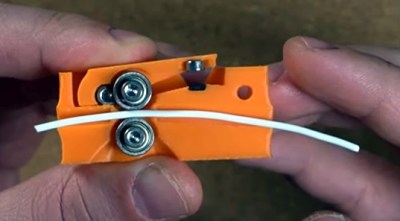As desktop 3D printers have inched towards something resembling the mainstream, manufacturers have upped their game across the board. Even the quality of filament that you can get today is far better than what was on the market in the olden days, back when a printer made out of laser-cut birch wasn’t an uncommon sight at the local makerspace. Now, even the cheap rolls are wound fairly well and are of a consistent diameter. For most folks, you just need to pick a well-reviewed brand, buy a roll, and get printing.
But as with everything else, there are exceptions. Some people are producing their own filaments, or want to make sure their extrusion rate is perfectly calibrated. For those that need the capability, the WInFiDEL from [Sasa Karanovic] can detect filament diameter in real-time while keeping the cost and complexity as low as possible. Even better, with both the hardware and software released as open source, it makes an excellent starting point for further development and customization.
 In fact, the WInFiDEL itself was developed from the earlier InFiDEL sensor designed by [Thomas Sanladerer]. This new version uses the same basic mechanism: a pair of bearings, with one fixed in position and the other attached to an arm with a magnet on the end. As the filament passes between the bearings, the arm raises and lowers the magnet, which is detected by a linear Hall-effect sensor. The resulting raw deflection data, once properly calibrated, provides a highly accurate readout of the filament diameter as it passes through the sensor and into the extruder.
In fact, the WInFiDEL itself was developed from the earlier InFiDEL sensor designed by [Thomas Sanladerer]. This new version uses the same basic mechanism: a pair of bearings, with one fixed in position and the other attached to an arm with a magnet on the end. As the filament passes between the bearings, the arm raises and lowers the magnet, which is detected by a linear Hall-effect sensor. The resulting raw deflection data, once properly calibrated, provides a highly accurate readout of the filament diameter as it passes through the sensor and into the extruder.
What’s changed is how the sensor is utilized. [Thomas] imagined the original sensor as being connected directly to the 3D printer’s motherboard, with its data being used to modify the extrusion rate during printing. In other words, it wasn’t really designed for humans to use. For the WInFiDEL, [Sasa] dropped the anemic ATTiny85 and replaced it with an ESP32 that can connect to your WiFi network and offer up a slick web interface, complete with a easy to use calibration tool and a rolling graph that plots out the data as it comes in. There’s also an API that allows you to hit the sensor with a web request to get current diameter and calibration data should you want to virtually connect it up to something like OctoPrint.
Most of us don’t need the WInFiDEL. But looking at the exceptional hardware and software of this project, we sure as hell want one anyway. Of course, we’d expect no less from [Sasa]. Whether its his OS-agnostic fan controller or ESP32 powered camera slider, his creations always exhibit a sort of simplistic elegance that we’re big fans of.
